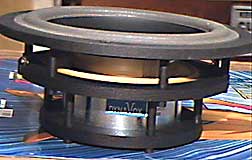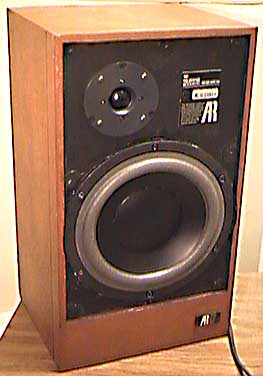PROJECT
AN EXPERIMENT IN BASS IN SMALL BOXES
For several months, I had been entertaining the idea of an experiment in small, but
life-like-sounding speakers. This may seem contrary to my style, but this was an academic
project. I wanted to see if I could pack a little insanity into a smaller box. :-)
Several months ago, I got the chance to do just that when an FM station that I work for
was disgarding an utterly destroyed pair of Acoustic Research AR-17 loudspeakers. When I
acquired them, they contained no working drivers whatsoever. A perfect clean slate! So I
waited for the right woofer to come along, and 5 months later, it did.
One day this month, I received the latest MCM Electronics catalog of special sale items
and in it, they had the Ulitmate 8-inch Woofer. I might have been willing to shell out
over $100 each, but they had slashed the price to $59, so I jumped at the opportunity.
MEASUREMENTS
I measured the frequency responce of the woofer, close in, so as not to receive drastic
effects of room echoes and phase cancellation. This is just an informal measurement, but
should give a good indication of response over the bass range.

LISTENING TESTS
All listening was done using a modified Hafler D500 amplifier, which put out
approximately 300 watts per channel into 8 ohms. CDs were used as source material.
I had mixed reactions when I began testing of this system. Small speakers are very
sensitive to placement in a room, and the size of the room matters a lot as well. At
first, I placed these on the floor in front of my main speakers. As it turns out, there
was ineffective room coupling at this location. But then, this large room, shaped and
insulated the way it is, acts like a bottomless pit for bass. It sucks up every bit of
lower register and leaves even large speakers sounding anemic. However, when I placed the
speakers tight into the corners, magical things happened to the lower register. Suddenly,
they sounded like much larger speakers. Later, I moved them to an alcove at the other end
of the studio and they sounded equally well and more open.
I played a variety of music through these speakers. Modern jazz, especially a selection
with booming, up-close-miked bass sounding stunning large, as if reproduced by 15"
woofers. These speakers do everything but shake the house--they sound very robust on the
low end. I played a Joe Hisaishi soundtrack for Mononoke Hime, a Japanese film,
and noted thunderous, rumbling bass down to 20 cps. (I fed a 20 cps sine wave into these
earlier and noted that they produced a meaningful and useful fundamental output, which is
unheard of from an 8" driver.) The big bass drums thundered, and as long as I kept
the volume moderate, the woofers handled it without bottoming. I played various types of
modern jazz and noted excellent transient response, crisp high end, and a punchy low end
that belied the size of these speakers. Finally I played an album of piano music and was
delighted at how the Steinway B2 concert grand came through with a richness and range that
spoke of high quality at every note on the scale. Detail was excellent, and the midrange
was surprisingly smooth for this small speaker. I measured sound pressure levels,
C-weighting, at 3 feet, during some progressive material feeaturing a lot of percussion
and noted SPLs hitting 114dB, not bad for a tiny pair of boxes.
When I listened to pipe organ on these, I didn't expect much, but because of the sealed
enclosure and the extremely long throw linear range of the woofers voice coil assembly, I
was able to hear the lowest notes reproduced. While it didn't shake the room, it did
render the impression that a subwoofer was present, for the bottom end was flat across the
bass range. My guess is that normal people will find this pair of speakers to have
super-adequate bass response.
I've been listening to this system for several hours now, and along the way found it
un-fatiguing and with the occasional surprise when some super low bass notes were
reproduced. At times I even FELT the bass just a little. For eights, they move a lot a
air. They make excellent production/recording monitors because they are accurate and
provide the full spectrum in a compact pair of boxes.
All that remains to be done is some cosmetic refinishing and then these will be ready
for use.
JUST ADDED
I picked up a decent deal on a Carver M-500 Magnetic Field Amplifier, after reaching
the conclusion that it would be a lot more convenient to have a dedicated amplifier for
the above speakers, rather than constantly rewiring my main system to break out one of the
Hafler amps. It's nicely matched to the speakers, providing plenty of punch and dynamic
headroom for a really lively sound that gets the most from these little speakers. There
are times when I can't believe the bass output from this secondary system, but it's there.
And transients of percussion are genuinely astounding on speakers with 4" voice coils
driving 8" cones. I now use this system for background music and for editing and
mixdown work I do in my CD mastering business. The savings on electricity from not having
to idle a great number of large amplifiers all day is working out to about $70/month.

Return to Bass Pig's Lair





